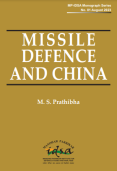China Yearbook 2012
- Publisher: Institute for Defence Studies and Analysis (IDSA)
An annual publication from the Institute for Defence Studies and Analyses (IDSA), The China Yearbook 2012 is a round-up of events and issues of significance that occurred in China during the past year and covers important developments in the domestic and foreign policy spheres.
- ISBN 978-93-82512-03-5,
- Price: ₹. 695/-
- E-copy available
- Rukmani Gupta
- 2013








